A deal to provide Iran with stockpiles of natural uranium that “significantly exceed” its needs raises concerns about the nature of Tehran’s nuclear program, Olli Heinonen, a former deputy director general of the International Atomic Energy Agency, wrote in a policy brief for the Foundation for Defense of Democracies on Tuesday.
Heinonen’s analysis was prompted by the recent news that the United States will allow the transfer of some 130 tons of natural uranium to Iran, enough to produce ten nuclear weapons. While Heinonen wrote that the transfer is permitted by the terms of the 2015 nuclear deal, the amount of uranium being transferred will “significantly exceed Iran’s needs for natural (that is, unenriched) uranium over the next 15 years.”
According to the nuclear accord, Iran is allowed to buy yellowcake — concentrated natural uranium — in order to replenish its stocks as it sells its enriched uranium. However, Iran has faced difficulties with selling its enriched uranium, which Heinonen called “unsurprising, given the current excess of commercially available enriched uranium.”
“This, however, has not stopped Iran from buying and stockpiling more yellowcake,” he added.
In addition to the roughly 130 tons transfer, Kazakhstan supplied Iran with 60 tons of uranium in December 2015 as requested by the nuclear deal’s Joint Commission , “as part of Iran’s ‘compensation’ for removing its excess low-enriched uranium above the JCPOA limits.”
However, since Russia is under contract to provide Iran with uranium for its civilian nuclear power plant at Bushehr, while the international community is obligated to supply Iran with fuel for its research reactors, “Iran has no need for such material during the next decade.”
In addition to the nearly 200 tons of uranium that Iran has received, Iranian President Hassan Rouhani also announced on January 1 that Iran will buy an additional 120 tons in the near future. Moreover, Iran produces uranium domestically from its mines at Gacchin and Saghand. Estimates from a recent report by the IAEA and the Organisation for Economic Cooperation and Development indicate that Iran domestically produced 35 tons of uranium in 2015 and will increase that figure to between 90 and 118 tons annually by 2020.
While Iran’s long-term research and development plans have been approved by the IAEA and the parties involved in the nuclear deal, “there is no plausible way those plans could justify the acquisition of several hundred tons of yellowcake,” Heinonen wrote.
Heinonen called for greater transparency about Iran’s plans, as well as assurances that it won’t be enriching yellowcake above 3.67 percent and won’t reprocess it without authorization, even after the deal expires.
Questions remain about whether Iran will remain committed to the nuclear deal after the end of President Barack Obama’s term in office. In November, Bloomberg View columnist Eli Lake observed that the Obama administration had adopted a “policy of going beyond the nuclear agreement to keep Iran happy,” and wondered if “without extra efforts like Obama’s, Iran will be tempted to walk away from the agreement altogether.”
In a similar assessment, Lee Smith, a senior fellow at the Hudson Institute, wrote that the Obama administration had kept the nuclear deal alive “by bribing Iran, drumming up business for the clerical regime, blocking Congress from imposing non-nuclear sanctions, and turning a blind eye to Iranian violations of the deal.” Assessing that the deal “would likely have collapsed under a Hillary Clinton administration as well,” Smith argued that “all that needs to happen for the deal to fall apart is for the Trump White House to do what the Obama administration has refused to do—enforce its provisions.”
[Photo: Nuclear Threat Initiative / YouTube ]




